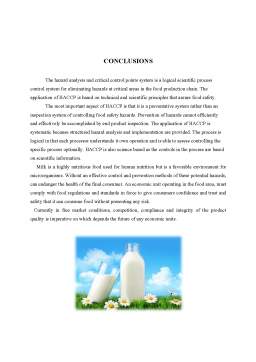Cuprins
- I PRODUCT DESCRIPTION.3
- 1.1 Physical properties.3
- 1.2 Chemical properties.5
- 1.3 Organoleptic properties.5
- 1.4 Use of the product.7
- II DESCRIPTION OF TECHNOLOGICAL PROCESS.7
- III IDENTIFICATION OF POTENTIAL HAZARDS.10
- 3.1 Physical hazards and prevention measures.10
- 3.2 Chemical hazards and prevention measures.11
- 3.3 Biological hazards and prevention measures.12
- 3.4 Analysis and risk assessment.14
- IV DETERMINATION OF CRITICAL CONTROL POINTS.16
- V HACCP PLAN DEVELOPMENT.16
- 5.1 Stages, dangers and critical limits.16
- 5.2 Monitoring procedures.17
- 5.3 Establishment of corrective actions.18
- 5.4 Establishment of documentation, records and responsibilities.20
- 5.5 Making of HACCP plan.20
- CONCLUSIONS.22
Extras din proiect
PRODUCT DESCRIPTION
Milk is a completely and irreplaceable aliment, due to its many beneficial effects, such as: mineralizing action to young people; antitoxic protection for persons working in toxic environments, many proteins etc.
Product description represents a very important step, because it contributes to the identification of potential hazards that could affect the harmlessness of food products and ultimately consumer health.
At this stage, the HACCP team must achieve a true audit of the product, including: complete description of raw materials, ingredients, packaging materials and finished products. The HACCP team should identify where the product is intended for general consumer or any "sensitive" categories of consumers, giving these details very clearly on the label of the product in compliance with the requirements concerning the labelling of foodstuffs.
1.1 Physical properties
Physical characteristics of milk expressed its structure and allows the appreciation of quality in relation to the requirements of the standard; at the same time, offers the possibility of detecting errors in technological service animals, possible diseases, but also to counterfeiting.
A) Density
Represents the unit of weight by volume of milk, respective, the weight of a liter of milk at a temperature of +20˚ C, compared to that of a liter of water at +40˚ c.This property of milk is given by the sum of its components and their specific weight. The normal values of the density are 1,028-1,033 for cow's milk and goat's milk and 1,030-1,035 for the buffalo and sheep.
B)Viscosity
Is the phenomenon of friction of the molecules of milk flowing and it depends on the state in which it is fat and casein. The viscosity of normal milk is 1,74-2.4, and the specific heat is 0,092-0.93 cal/gr.
C) Opacity
Is milk and photoconductive correlates with the totality of the radiation of light that they reflect the milk; It depends on the content of milk fat, protein and some minerals. Opacity is distinguished by observing the water rising milk on the walls of a glass vessel; It allows the degree of freshness and sanitation of milk.
D) Osmotic pressure
Is determined by the number of molecules or particles of milk, with different osmotic pressures (lactose-3 atm.; chlorides and salt-1.33 atm.; other salts-2.42 atm.). Osmotic pressure of milk is 6, 78 atm.
E) Freezing point
Is the temperature to which the milk freezes respectively-0,52, -0,59˚C; This appropriation is only dependent on the concentration of dissolved substances in milk, without being influenced by the protein and lipid content.
F) Boiling point
Under the action of heat, the milk boils and pass into vapor at a temperature of +100,550 ºc, under conditions of normal pressures 750mmHg.Oscillations boiling point allow identification of tampering by adding water.
G) Specific heat
Is the number of calories required to raise with 10˚ C the temperature of a gram of milk; the specific heat of milk is 0.94 calories/g/degree.
H) Thermal conductivity
Is the property of milk to transmit heat, showing its strength at various temperatures.
I) Refractive index
Is given by the ratio of the speed propagation of light radiation in the origin and propagation speed in the environment in which they penetrate. The value of the refractive index is 38-400Zeiss, but decreases in case of tampering with the water and mastitis milk.
J) Surface tension
Is the force that is exercised to milk contact surface with the air and is 45-53 Dyne/cm2 to whole milk. When exceeding the value of 55 Dyne/cm2, milk is suspected of tampering with the addition of water.
Preview document
Conținut arhivă zip
- HACCP of Milk Production Line.docx






















